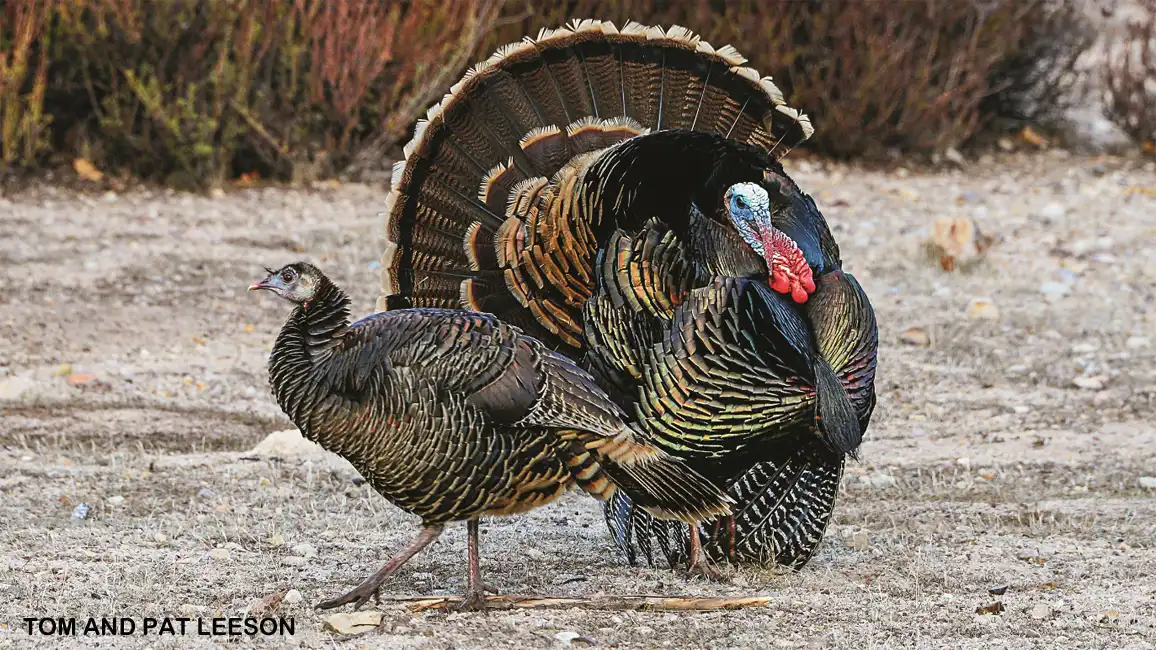
Talkin’ Turkey
By Ellen Lambeth
As you can see, a turkey wears all-American colors. At least the male does, on his bare-skinned head and neck, when he’s trying to attract the attention of a female. That’s what this proud, puffed-up male is doing—spreading his fine, fancy feathers and saying, “gobble-gobble.”
Not too many species of birds live all year round in nearly every U.S. state. The wild turkey is one you can count on (unless you live in Alaska—the only state it’s not found in).
There were tons of turkeys before Europeans crossed the Atlantic Ocean and settled in North America. Native Americans—the people who already lived here—depended on these big chicken-like birds. They used their meat for food and their feathers to make special headdresses. And they protected the land that the turkeys needed for survival.
But when the settlers moved in and spread across the country, they hunted too many of the birds. They also changed the land, clearing forests and plowing up prairies to make farmland. By the early 1900s, there weren’t so many wild turkeys left. But with help and protection from people who cared, their numbers started to grow again.

WILD FRONTIER
What do turkeys need to survive? Mostly forests filled with trees and shrubs that grow lots of nuts and berries. Turkeys usually spend their days in flocks on the ground, eating fallen nuts and berries, as well as grains and other seeds. They eat insects, too—and even an occasional salamander or lizard. When it’s time to roost (sleep) at night, they fly up into the trees, away from predators that may be hunting for a meal down below. But what if a bobcat or coyote comes across a turkey on the ground? The turkey can run fast. It can even fly up and away for short distances—as fast as a car goes on the highway!
FAMILY AFFAIR
Each spring, turkeys prepare for new families. Most of the time, male and female wild turkeys look about the same, with their bare heads and dark, glossy feathers. But during mating season, the males—called toms—really spruce up! The skin on their heads and necks turns a bright red-white-and-blue. They gobble-gobble to say “I’m here—and I’m the greatest!” Then they fan out their tail feathers, peacock-style. They lower their wings. And they strut, while puffing up their shiny feathers and dragging their wingtips across the ground.
What hen (female turkey) could resist that? The toms even compete with each other for a mate. Their fights can be brutal, especially when they kick each other with the sharp spurs on their legs.
After a tom and hen have mated, he hangs out with the other guys while she does all the work raising the family. She scratches out a spot on the ground and lays about a dozen eggs. If a skunk or other egg-eater doesn’t snatch the eggs, the young—called poults—hatch, fully feathered and almost ready to run. Within a day or two, they’re finding and catching their own meals. But they stick with Mom for about a year.

TABLE-TOP TURKEY
When it comes to the traditional Thanksgiving dinner, turkey is usually at the top of the menu. But most people aren’t eating wild turkeys. They buy meat from farm-raised turkeys like the white ones at left. You also may have seen such turkeys getting pardoned each year by the U.S. president at the White House, so they can live to see another day.
These turkeys no longer have their natural colors, and they’re bred to be especially big and meaty. They’re so heavy, they can’t fly. It’s not quite the same life as that of wild turkeys.
TURKEYS ON THE TOWN
In some places, there are now many more wild turkeys than before. They’re turning up in towns and even cities—maybe in a neighborhood near you! In most cases, they might just happen to pass through a yard. But sometimes, they act as if they owned the place! They may even charge at you if you get in their way. So, if you happen to meet a turkey on a sidewalk, don’t mess with it. Just say “Good day!” and head the other way.
















